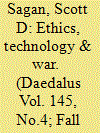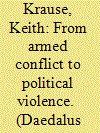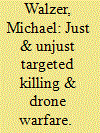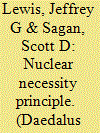|
|
|
Sort Order |
|
|
|
Items / Page
|
|
|
|
|
|
|
| Srl | Item |
| 1 |
ID:
147554


|
|
|
|
|
| Summary/Abstract |
There is growing concern in some quarters that the drones used by the United States and others represent precursors to the further automation of military force through the use of lethal autonomous weapon systems (LAWS). These weapons, though they do not generally exist today, have already been the subject of multiple discussions at the United Nations. Do autonomous weapons raise unique ethical questions for warfare, with implications for just war theory? This essay describes and assesses the ongoing debate, focusing on the ethical implications of whether autonomous weapons can operate effectively, whether human accountability and responsibility for autonomous weapon systems are possible, and whether delegating life and death decisions to machines inherently undermines human dignity. The concept of LAWS is extremely broad and this essay considers LAWS in three categories: munition, platforms, and operational systems.
|
|
|
|
|
|
|
|
|
|
|
|
|
|
|
|
| 2 |
ID:
147552


|
|
|
| 3 |
ID:
147561


|
|
|
|
|
| Summary/Abstract |
Most contemporary lethal violence does not occur in conflict zones, the majority of states most affected by lethal violence are not at war, and the levels of lethal violence in many nonconflict settings are higher than in war zones. Much of this nonwar violence is organized, not random, and political in nature. A narrow focus on wars and formal armed conflicts thus obscures the high levels of everyday violence and insecurity around the world. This essay makes the case that adopting a broad understanding of political violence – including violence committed by the state and its agents, and nonphysical violence as the violation of basic rights – is essential to gain insight into the causes and consequences of, and to frame appropriate responses to, war and violence in the twenty-first century.
|
|
|
|
|
|
|
|
|
|
|
|
|
|
|
|
| 4 |
ID:
147553


|
|
|
|
|
| Summary/Abstract |
Targeted killing in the “war on terror” and in war generally is subject to familiar and severe moral constraints. The constraints hold across the board; they don't change when drones are the weapon of choice. But the ease with which drones can be used, the relative absence of military risks and political costs, makes it especially tempting not only to use drones more and more, but also to relax the constraining rules under which they are used. It seems clear that the rules have, in fact, been relaxed in the course of the American experience with drone warfare – by presidential decision and without public debate. This essay is an argument for the opening up of the decision process to democratic scrutiny and in defense of the familiar constraints.
|
|
|
|
|
|
|
|
|
|
|
|
|
|
|
|
| 5 |
ID:
147555


|
|
|
|
|
| Summary/Abstract |
The emergence of cyber means and methods of war, force, and coercion raises ethical questions under just war theory different from those historically generated by the development of ever more destructive instruments of war. Whether in armed conflict or contexts not considered war, cyber technologies create political and ethical incentives for their use. However, this attractiveness poses potential risks and dangers that, at present, are largely speculative but invite more ethical deliberation. Unfortunately, the convergence of political and ethical incentives on cyber in a context of increasing geopolitical competition and conflict make the prospects for ethical consensus on just and unjust cyber coercion, force, and war unlikely.
|
|
|
|
|
|
|
|
|
|
|
|
|
|
|
|
| 6 |
ID:
147562


|
|
|
|
|
| Summary/Abstract |
Since the end of the Vietnam War, the United States has refrained from the widespread, intentional targeting of civilian populations in times of war. Public opinion polls seem to reflect a marked decline in American support for targeting foreign civilians since that time. Drawing on original public opinion surveys, as well as other historical material, this essay explores several explanations for these changes. Although there is some evidence that the public's views about the morality of civilian targeting have shifted, I argue that two other explanations also play an important role in the changes in the conduct of American wars. First, a mounting skepticism, especially within the U.S. military, about the efficacy of killing civilians, has undercut the primary motivation to even consider such tactics. Indeed, many U.S. military leaders now perceive that killing adversary civilians in large numbers – intentionally or unintentionally – usually backfires, making the adversary fight harder or driving more civilians to join or support the adversary's forces. Second, due to the lower stakes, and especially the dramatically lower fatality rates suffered by American troops in recent wars, the temptation to attempt to end wars quickly with a “death blow” against adversary cities has become less potent. Under certain conditions, however, a majority of Americans would still support today the kind of population bombing last practiced during World War II.
|
|
|
|
|
|
|
|
|
|
|
|
|
|
|
|
| 7 |
ID:
147559


|
|
|
|
|
| Summary/Abstract |
New technological advances in areas such as digital information, algorithmic forensic data analysis, autonomous surveillance vehicles, advanced robotics, and multispectral sensors (sometimes all working together) can help avert war, introduce more effective peacekeeping and peacemaking initiatives, lessen the impact of conflict on innocent people, and help rebuild war-torn states. When international humanitarian action becomes urgent, by way of knowledge gained through such technologies, then those same peace applications can be used to reduce harmful forms of intervention and to ensure that enforcers are abiding by international law and UN guidance. An ethical failure occurs when such technologies exist to save lives, reduce risks, and secure peace, but are not employed.
|
|
|
|
|
|
|
|
|
|
|
|
|
|
|
|
| 8 |
ID:
147557


|
|
|
|
|
| Summary/Abstract |
In 2013, Obama administration spokesmen stated that all U.S. nuclear war plans “apply the principles of distinction and proportionality and seek to minimize collateral damage to civilian populations and civilian objects.” We analyze U.S. nuclear policy documents and argue that major changes must be made if U.S. nuclear war plans are to conform to these principles of just war doctrine and the law of armed conflict. We propose that the U.S. president announce a commitment to a “principle of necessity,” committing the United States not to use nuclear weapons against any military target that can be destroyed with reasonable probability of success by a conventional weapon. Such a doctrinal change would reduce collateral damage from any nuclear strike or retaliation by the United States and would, we argue, make our deterrent threats more credible and thus more effective.
|
|
|
|
|
|
|
|
|
|
|
|
|
|
|
|
| 9 |
ID:
147556


|
|
|
|
|
| Summary/Abstract |
While nuclear weapons were conceived to end a war, in the aftermath of their operational use at Hiroshima and Nagasaki, they became the central (and controversial) means to prevent a war. Nuclear deterrence formed the foundation of U.S. Cold War doctrine and the basis of an extended security guarantee to our allies. But the Cold War ended one-quarter century ago, and questions about the efficacy of deterrence, the need for nuclear weapons, and the ethics surrounding them have resurfaced as some call for further major reductions in inventory or the complete elimination of the U.S. nuclear arsenal. Discussed from the perspective of a military practitioner, this essay highlights the continuing need for U.S. nuclear weapons in a global security environment that is highly complex and uncertain, and describes the means by which the credibility of the nuclear portion of the strategic deterrent is being preserved even as the role and prominence of these weapons have been reduced.
|
|
|
|
|
|
|
|
|
|
|
|
|
|
|
|
| 10 |
ID:
147560


|
|
|
|
|
| Summary/Abstract |
For just war doctrine to apply, the last resort requirement to exhaust all measures short-of-war must be fulfilled. Because of research and policy developments in the last fifteen years, the international community is now equipped with a richer understanding of how wars and atrocities evolve through time, improved precision about trigger points and risk factors that may accelerate that evolution, growing consensus on what prevention and mitigation steps to look for in that process, and new technologies for ascertaining these steps in order to intervene when mitigating action might deflect the escalation. It is thus argued that the responsibility of the international community to intervene in a timely and appropriate fashion has become increasingly clear and inescapable. It is further argued that the alert engagement of civil society in crafting this body of research and policy places a heavy public burden on government leaders to demonstrate that indeed all measures short-of-war have been exhausted. We now have at our collective disposal many more measures to deploy and many more witnesses to raise the alarm. Accordingly, the threshold for declaring that last resort has been reached has now become much higher.
|
|
|
|
|
|
|
|
|
|
|
|
|
|
|
|
| 11 |
ID:
147558


|
|
|
|
|
| Summary/Abstract |
Despite the commitment made by all heads of state attending the 2005 World Summit to uphold the principle of the responsibility to protect (R2P), atrocity crimes continue to be committed by states and nonstate actors. This essay argues that assessments of R2P's effectiveness too often overlook the political nature of the principle – with the strengths and weaknesses that this status entails – and apply rigid standards of success that both underestimate its contribution to building capacity to prevent and respond to atrocity crimes and overemphasize the role of military intervention. It also suggests that R2P is best understood as a “duty of conduct” to identify when atrocity crimes are being committed and to deliberate on the best form of collective response. The cases of Libya and Syria have nonetheless raised fundamental questions about the prospect of catalyzing international efforts to protect populations, particularly when there is disagreement over the costs and benefits of a coercive response.
|
|
|
|
|
|
|
|
|
|
|
|
|
|
|
|
|
|
|
|
|